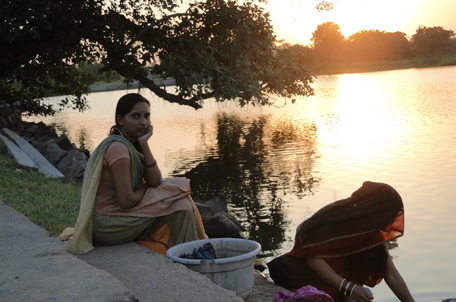
Village Kanti is situated 37 km away from Teekamgarh District of Madhya Pradesh and 42 km from Block Jatara. The village has 132 household with population of 633. The majority of population is dalit (Schedule Caste) & sahariya tribes. The main occupation of the villagers is farming, livestock rearing & wage earning. On the upper side of village, there is a Chandela period Pond named as “baijana” from years ago.
Chandelas and Bundelas were the two major dynasties in the region which took keen interest in conserving water as a means of supporting livelihood and development of region. Chandela tanks were constructed by stopping the flow of water in rivulets flowing between hills by erecting massive earthen embankments, having width of 60m to 120m or more. These hills with long stretches of quartz reefs running underneath them, acted as natural ground water barrier helping to trap water between the ridges. The earthen embankments were supported on both sides with walls of coarse stones, forming a series of stone steps. Chandela tanks usually had a convex curvature somewhere in the middle of the embankment; many older and smaller tanks were constructed near the human settlement or near the slopes of a cluster of hills. These tanks served to satisfy the drinking water needs of villagers and cattle. These tanks are currently facing several problems as siltation of their beds, encroachment of their Catchment, illegal occupation of the tank bed and gross neglect by the Government as well as the community.
The Chandela tank of Kanti had water area around 7 acre in that time but due to lack of maintenance, it has reduced to only 4-5 acre water area at present. The older people of village told that earlier they were depended on this pond for drinking water, bathing, cloth washing and other domestic purposes. The tank faced the problem of seepage due to which it could not store water. The recharge of the drinking water sources such as hand pumps, well etc are largely dependent on this pond, as this pond is situated at the upper side of the village. Till the pond has water only then the hand pump & wells provides water otherwise in summer season as the pond becomes dry then creates the crisis of drinking & irrigation water.
Integrated Water Resource Management project implemented in this village since March 2011 with support from European Union and Viva Con Agua. Under the project, community was organized to form PANI PANCHAYAT (Community Based Organization). In regular meetings of PANI PANCHAYAT, the community discussed about stopping the leakage system of “Baijna” pond on priority basis. In the Water User Master Plan (WUMP) of this village, they prepared action plan for maintenance of this pond to stop leakage system. They placed the demand before the Local Government for maintenance and deepening of the pond. Rs 184382/ (2560 Euro) – was utilized from project for the construction works. The community (78 Families) also contributed one day labor. After the construction, now the water leaking through walls has totally stopped. The entire pond is full of water and seeing the same, the community has long smiles on their face. Seeing the impact panchayat (Local Government) has sanctioned Rs. 4, 80,000/ (6666 euro) for deepening of the pond. Villagers were happy to share that the project has changed the water scenario of the village. Now at least they will get drinking water from their tube wells and wells even during crisis months of summer .




